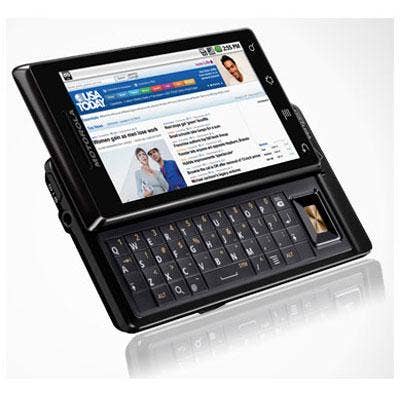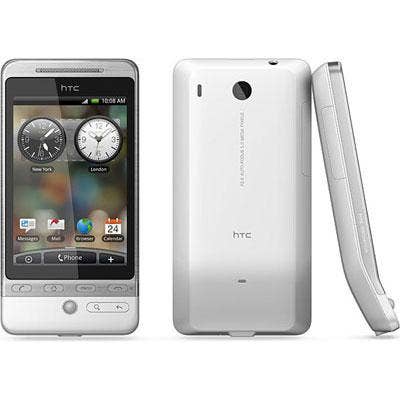Android Invasion: Hot Devices Driving Google's OS Blockbuster

Android Attack
Google's Android is everywhere you look these days, and according to researchers, its growth has been astounding; Canalys reported 886 percent year-over-year growth in shipments of Android-based smartphones in the second quarter.
Android has emerged as a viable competitor to leading mobile device OSes from Apple, Research In Motion, Microsoft and others, and its presence isn't just in smartphones, either. Here's a look at some of the hottest Android devices in the galaxy -- smartphones and beyond -- that helped pave the way for Android's glory and are setting it up as a mobile powerhouse well beyond 2010.

T-Mobile G1/HTC Dream
You always remember your first. Launched in October 2008, the T-Mobile G1 phone was the first publicly available mobile device based on Google Android to hit U.S. shores. With a 3.2-inch touch screen, horizontal slide-out QWERTY keyboard, 3.2-megapixel camera with autofocus, 5.8 hours of battery talk time, Qualcomm MSM7210A 528 Mhz processor and Wi-Fi, Bluetooth and GPS enablement, it can still hang with plenty of phones out there.

Motorola Droid
Released last fall, it was the first big-splash Android smartphone: a powerhouse (for the time) of features and a hype cycle -- complete with splashy advertising campaign -- worthy of Apple. Motorola's first Droid has a 3.7 inch touch screen, 5-megapixel camera with autofocus, 7 hours of talk time, an OMAP3430 processor, 512 MB of Flash memory, 256 MB RAM, and a micro SD slot expandable up to 16 GB. It was also the first Android phone to include Android 2.0, which in November 2009 was the most up to date version available.

HTC Hero
Heroic indeed. Hero was the first Android smartphone to be carried by Sprint and it sports beveled edges, an antifingerprint screen coating, a 3.2-inch HVGA touch-screen display with pinch-to-zoom, embedded GPS, a digital compass, a gravity sensor and a 5-megapixel camera. It was also the first U.S. smartphone to use HTC Sense, which allows users to customize their home screens using different panels and widgets and is now seen on several HTC phones.
Around the same time came the release of the HTC Droid Eris, a Verizon version of the Hero that's slightly smaller than the Hero but has almost all of the same features.

Motorola Cliq
Though quickly overshadowed by Droid, Motorola's Cliq was also a major Motorola Android release last fall, and it was also the first phone to use Motorola's MotoBlur, an Android skin with customizable widgets. It has a 3.1-inch touch screen with QWERTY slide-out keyboard on the side, and a 5-megapixel camera, 6 hours of battery talk time, a Qualcomm MSM7201A 528 MHz processor, Wi-Fi, Bluetooth, GPS, 256 MB and a microSD slot expandable to 32 GB.

Samsung Moment
We still have a soft spot for one of Samsung's first major Android forays, the nine-month-old Moment. It has a 800 Mhz processor, 3.2-inch AMOLED screen, optional trackpad, a 3.2-megapixel camera, and all the usual Google search and Google bells and whistles that come standard with Android OS phones.

T-Mobile MyTouch 3G/HTC Magic
T-Mobile's second major Android smartphone, the MyTouch 3G (also known as the HTC Magic), has a 3.2-inch touch screen, 5-megapixel camera, 7.5 hours of battery talk time, a Qualcomm MSM7201a 528 Mhz processor, Wi-Fi, Bluetooth and GPS. Included applications were a big deal around the time of the MyTouch's launch a year ago, with apps like the learning engine Sherpa being touted as big selling points.

Google Nexus One
Ah, Nexus One, we never knew ye. Though manufactured by HTC, Nexus One, launched to great fanfare in January 2010, was Google's proprietary smartphone and seen as Google's major entry into a Web retail operation of its own. Sales shortcomings and customer services nightmares abounded, however, and not six months later, Google decided it would end sales of Nexus One through its online Web store and rejigger its strategy for moving the devices. Pound-for-pound, the Nexus One can hang with most other Android offerings available: it includes a 1 Ghz Snapdragon processor, a 5-megapixel camera, and a dual mic for noise suppression, as well as the other common Android bells and whistles. It was also the first Android phone to be upgraded to Google Android 2.2, aka Froyo.

HTC Aria
All eyes are on AT&T, with most agreed that it's a question of when, not if, the carrier will lose its exclusive agreement with Apple to carry iPhone in the U.S. AT&T seems to think so, too, and has spent a lot of time and energy in 2010 making sure it expands to other platforms. Along with the just announced BlackBerry Torch 9800, AT&T has also made several forays into the Android world this year, and the HTC Aria -- Android 2.1, HTC Sense, a 5-megapixel camera, a 3.2-inch HVGA touch screen display with optical joystick and other features -- is probably the best of them. It is also AT&T's second Android-based smartphone, following the Motorola Backfip.

HTC Droid Incredible
"Breathless" would be the word describe reviews for the HTC's Droid Incredible, which stormed into the smartphone market in April and, before Droid X stole back the limelight in July, was the most-buzzed about of new Android phones with a Droid brand. It has a 3.7-inch, 480 x 800 WVGA AMOLED display, an 8-megapixel camera, Android 2.1 with HTC Sense, a 1-Ghz Snapdragon processor, 8 GB of internal memory and a soft outside shell form factor, unique to many of the Droid and Android devices currently on the market. It was Verizon's first smartphone to include Snapdragon, and also Verizon's first with an 8-megapixel camera.

HTC EVO 4G
An early contender for the year's coolest smartphone -- though there's plenty of new competition -- the HTC EVO 4G, carried by Sprint, might be the most advanced widely-available device out there. It has a 4.3-inch, 480 x 800 display, 1 Ghz Snapdragon processor, an 8-megapixel camera with 720p HD video capture capability, HDMI output, Google Android 2.1 (with 2.2 on the way), HTC Sense, and, most notably, 4G integrated wireless, which means HTC and Sprint can lay claim to having the first 4G smartphone available to consumers in the U.S.

Samsung Galaxy S
With the all-hands-on-deck release of its Galaxy S line of smartphones, it's clear Samsung wants its next Android assault to be remembered. The vendor has made versions of the Galaxy S phone available to five U.S. carriers, including all four majors, and while the phones are slightly different, all four include Android 2.1 (with a 2.2 upgrade expected later this month), a 4-inch AMOLED display, a 1-Ghz processor, a 5-megapixel camera, 2 GB of storage and Bluetooh, GPS and Wi-Fi. T-Mobile's version, the Samsung Vibrant, was the first to be confirmed, but the Captivate (AT&T), Epic 4G (Sprint), Fascinate (Verizon) and Galaxy S (U.S. Cellular) are all on the way.

Motorola Droid X
Motorola proclaimed its loyalty to Android in 2009, and has never looked back, following one triumph (the original Droid) with another, Droid X. Droid X, which has only been available a few weeks and for which Motorola and Verizon are hustling to finish the pre-order backlog, offers a 4.3-inch display, video capture for 720p video, HDMI output, 1-Ghz processor, 8 GB of memory, 16-GB microSD card, 8-megapixel camera, no physical keyboard, Swype touch screen typing software, Android 2.1 (with 2.2 coming soon), 3G Mobile Hotspot capability, and a range of content options through partnerships with Skype Mobile and other vendors. Currently the class of Android smartphones?

Dell Streak
Is the Dell Streak, previously known as the Mini 5, a tablet or a smartphone? Either way, the device got people talking, and although it isn't yet available in the U.S. (it launched in the U.K. in June), has kept them talking. The device, which Dell calls a "companion" and which will run Android 2.2 later in the year, includes a 5-inch capacitive touch screen, a Snapdragon processor, 1.63 MB of flash memory, a micro SD slot expandable up to 32 GB, and two cameras (one 5-megapixel and the other VGA). Dell hasn't confirmed much, but rumors persist that 7-inch and 10-inch models are forthcoming.

Barnes & Noble Nook
Barnes & Noble late last year rolled up its sleeves and decided it wasn't going to let Amazon and Kindle gobble up the entire e-reader marketplace without a fight. As such came Kindle's most direct competitor, the Barnes & Noble Nook, an Android-based e-reader with built-in Wi-Fi, replaceable battery, SD slot and a few other features that took it beyond what the Kindle 2 had already. While Amazon, Barnes & Noble and the other titans of the e-reading world battle it out, however, it's platforms like Android that are winning: Android powers the devices and several of the e-book vendors have also made versions of their e-reading applications fit for Android devices.

Spring Design Alex
Thanks to Barnes & Noble's Nook, Spring Design's Alex became rather unfortunately known as "the other two-screen e-reader," but as a feature-packed e-reader and Android device, it's not worth brushing off. It weighs 11 ounces, and has a 3.5 touchscreen LCD on the bottom and 6-inch EPD display up top, the former for Web browsing and the latter for e-reading. It also offers Wi-Fi and a USB port, and Spring Design has previously said that a 3G version of the Alex will be made available this year.

Cisco Cius
Will Android climb aboard and dominate tablets the way it has smartphones? That remains to be seen, and though rumors have swirled that Asus, HP and especially Samsung (Galaxy Tab anyone?) were/are going to make a run at an Android tablet, the most visible example of Android appearing on a tablet device so far has been courtesy of ... Cisco. Yep, that Cisco, which leapt into the tablet game with both feet in June by announcing an Android-based tablet set to be sold through channel partners as part of Cisco's UC and collaboration portfolio.
Among the Cius' highlights are realtime video, multiparty conferencing, e-mail, messaging, Web browsing, and cloud-based content sharing. It checks in at 1.5 pounds and includes a front-mounted 720p HD camera and a 7-inch VGA touch-target display, a 5-megapixel rear-facing camera, 8 hours of battery life, an accelerometer and support for 802.11 a/b/g/n Wi-Fi and 3G, with 4G services also promised. It'll also be supported by Cisco's Unified Communications Manager and provide support for Cisco Quad and a range of other Cisco collaboration tools.
Cisco has yet to confirm pricing and said customer trials will begin in the third quarter of 2010, with Cius available in the first quarter of 2011. It's an experiment for sure -- tablets are new territory for Cisco -- but talk about a company that loves to experiment.